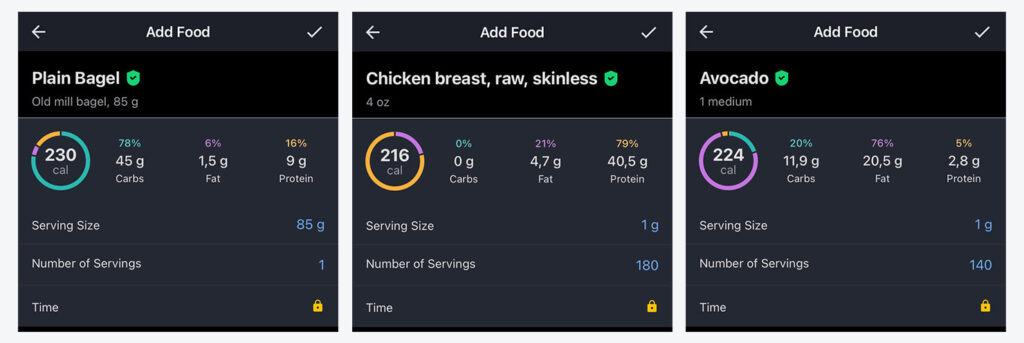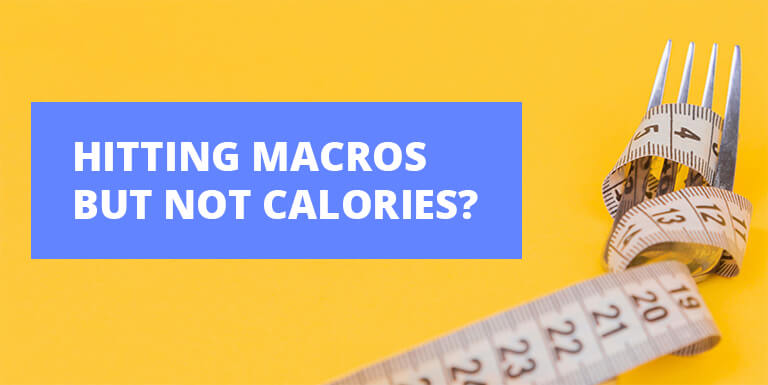The Reason You Are Hitting Calories But Not Macros (How to Fix It)
Are you hitting your calories but not macros? If so, you’re not alone.
It’s a common problem that many people face when they first start tracking their calories and macros.
In this article, I will explain the main reason why this is happening and how you can fix it.
But first, let’s go through some basics.
- Overview of Calories and Macros
- The Main Reason You Are Hitting Calories But Not Macros
- How to Hit Your Macros and Calories Consistently
- Frequently Asked Questions About Hitting Calories and Macros
Overview of Calories and Macros
Simply put, calories are a unit of energy. Your body needs calories to function properly, and the number of calories you need depends on your activity level, age, weight, and other factors.
You can estimate how many calories you need by using an online TDEE calculator.
TDEE stands for Total Daily Energy Expenditure.
By consuming more or fewer calories than your TDEE, you can gain or lose weight, respectively. And by eating at your TDEE, you can maintain your weight.
Moving on, there are three main macronutrients or macros, for short, that make up the calories in the food you eat are:
- Carbohydrates
- Protein
- Fats
Each macronutrient has a different number of calories per gram:
- 1 gram of carbohydrates contains 4 calories
- 1 gram of protein contains 4 calories
- 1 gram of fat contains 9 calories
Macronutrients also have different purposes in the body, for example:
- Carbohydrates are the body’s main source of energy
- Protein is needed for growth and repair, including muscle growth
- Fats are needed for many essential purposes, including hormone production, absorption of certain vitamins and others
Macros and calories are related, meaning that if you consume more or less of one macronutrient, it will affect the number of calories you eat. In other words, hitting your macros means also reaching your calorie goals. If you find yourself hitting your macros but not your calories, then something else is wrong, but it’s not the topic of this article.
Now that we’ve gone over the basics of calories and macros, let’s get into the main reason why you are hitting your calories but not macros.
SUMMARY
Calories are a unit of energy and macros are the macronutrients that make up the calories in food. Hitting your macros means also hitting your calorie goals.
The Main Reason You Are Hitting Calories But Not Macros
The main reason you are hitting your calories but not macros is because of poor meal planning.
It’s likely that you’re eating too much of one macronutrient and not enough of another due to the food choices you’re making. It is very common that you would overconsume carbs and/or fats and undereat protein.
Foods have different macronutrient compositions, which means that some foods are higher in carbs, some are higher in protein, and others are higher in fat.
For example, a bagel is mostly carbs with some protein and fat, whereas chicken breast is mostly protein with barely any fat. And avocados are mostly fat with some carbs and protein.

For example, if you only consume chicken breast and bagel, you would be hitting your protein and carb macros but not your fat macros.
To hit your calorie and macro targets consistently, you need to be mindful of the foods you’re eating, and their macro composition, as well as find a good balance of all three macros in your diet. To learn what foods contain what macros check out this macro cheat sheet.
SUMMARY
The reason why you are hitting your calories but not macros is that you’re not planning your meals properly, and you’re not getting a balance of all three macros due to poor food choices.
How to Hit Your Macros and Calories Consistently
Below are some best practices and actionable steps you can take to make hitting specific macronutrients easier.
NOTE
If you haven’t figured out how many calories and macros you would need to consume to reach your fitness goals, I suggest using an online macro calculator or calculating macros specifically for bulking or cutting phase.
The best way to make hitting your macros and calories easier is to create a balanced meal plan with 3 – 4 meal variations for breakfast, lunch, and dinner that you enjoy eating. That would be 9 – 12 meals in total. Plus, some snacks in between meals if needed.
This will help you stay on track with your diet and you won’t get bored eating the same foods day in and day out.
When creating such a meal plan you must ensure that the overall calories and macros fit your goals and that the meals contain a good balance of all three macros. Each type of meal (be it breakfast, lunch, dinner or a snack) must have a similar macronutrient composition so that you could rotate them and still hit your calorie and macro goals.
Once that is done, there are only two scenarios in which you could struggle to hit your macros while reaching the calorie target:
- You haven’t built your meal plan correctly. The overall macros and calories don’t fit your goals once you put all the meals together.
- You could not follow the meal plan or prefer a flexible dieting approach. For some reason, you could not follow the meal plan and had to improvise to make sure you hit your macros. Or, you simply prefer a more flexible dieting approach, and closer to the end of the day, find yourself hitting your calories but not macros.
If either of these two scenarios sounds familiar, don’t worry, there are solutions for both.
Let’s look at the steps you can take to fix the issue depending on which of the two scenarios you find yourself in.
You Haven’t Built Your Meal Plan Properly
If you follow your meal plan but still find yourself hitting your calories but not macros, it is likely that your meal plan is not built correctly.
It is likely that you will find yourself undereating some macros while overeating others. This can be easily fixed by changing up your meals to get a better balance of macros – increasing the intake of macros that you are falling short on, and reducing the intake of macros that you are consuming in excess.
Here are some steps you can take to fix the issue, depending on which macros you are missing.
You Are Under Your Protein Macronutrient Target
If you are hitting your calorie target but falling short on protein, you need to include more of the high-protein foods in your diet and cut down on other macronutrients to make up for the calories.
Some good high-protein foods include:
- Chicken breast
- Lean beef
- Turkey breast
- Fish
- Cottage cheese
- Eggs
- Greek yoghurt
- Icelandic yoghurt (Skyr)
Simply substitute some of the lower protein foods in your diet for these high-protein foods, and you should start hitting your protein macros more consistently.
Additionally, you can substitute some of the snacks with protein bars or protein shakes to help you reach your protein intake target.
You Are Under Your Fat Macronutrient Target
If you are falling short on fats, you need to include more high-fat foods in your diet and decrease the number of carbs and protein in your diet to make up for the calories.
Some healthy fat sources include:
- Avocados
- Nuts and nut butter
- Seeds
- Oils (coconut oil, olive oil, avocado oil)
Just substitute some of the lower-fat foods for these high-fat foods, and you should start hitting your fat macros more consistently.
Additionally, you can have a handful of nuts or a small piece of dark chocolate as a snack instead of snacks that are lower in fats.
By far the simplest way of increasing your fat intake is to simply use more oil when cooking your meals or drizzle it over already cooked meals. Just remember to cut down on carbs and protein to make up for the extra calories from fat since oil is very calorie-dense and can quickly make you go over your calorie target.
You Are Under Your Carbohydrate Macronutrient Target
If you are hitting your calorie and protein targets but falling short on carbs, you need to include more of the high-carb foods in your diet.
Some food sources high in carbs include:
- Rice
- Pasta
- Oats
- Quinoa
- Bread
Simply start including more of these foods in your diet, and you should start hitting your carb macros more consistently.
Additionally, you can have a carbohydrate-rich snack such as a granola bar, a bagel with a spread like jam, or a bowl of cereal.
By being able to make these simple changes to your meal plan depending on which macronutrient you are falling short on, you will be able to build a plan that is balanced and in line with your calorie and macro goals.
To create a meal plan you can use my free macro meal plan template which allows you to create a customized meal plan according to your specific calorie and macro goals.
You Could Not Follow the Meal Plan or Prefer a Flexible Dieting Approach
On the other side, it could be that you could not follow the meal plan on a particular day. OR it could be that you just prefer a more flexible dieting approach such as IIFYM (If It Fits Your Macros).
And closer to the end of the day, you find yourself close to hitting your calorie intake goals but still falling short on hitting your macros.
If this is the case, then you can make up for the shortfall by having a snack that is high in the macronutrient(s) you are falling short on.
Below are some examples of how you can make up for the macros you are falling short on.
You Are Under Your Protein Macronutrient Target
If close to the end of the day you find yourself under your protein target, you can have a high protein meal or a snack such as:
- Whey protein shake (just with water or milk if you have some room for carbs and fat)
- Can of tuna in brine or springwater
- Egg whites
- Grilled chicken breast
- You can also mix protein powder into Icelandic yoghurt (Skyr) for a high-protein snack that has some carbs and a bit of fat
You Are Under Your Fat Macronutrient Target
If you are under your fat target for the day, you can have a high-fat meal or snack, for example:
- A tablespoon of peanut butter
- Handful of nuts
- Piece of dark chocolate (if you also have room for some carbs)
You can also add some healthy oil (olive, avocado, sesame, or coconut oil) to your last meal of the day when cooking. Or after the meal is done you can simply drizzle some oil over the meal.
You Are Under Your Carbohydrate Macronutrient Target
If you are under your carbohydrate target, you can have a high-carb meal or snack like:
- Bowl of cereal with fruit
- Slice of bread or an English Muffin
- Bagel or cookie with or without jam or marmalade
- A granola bar with juice or some candy is also a good option for hitting your carb macros at the end of the day
You Are Under Your Protein and Fat Macronutrient Target
If you are under your protein and fat macros for the day, you can have a high-protein and high-fat meal or snack such as:
- Protein powder and nut butter blended into a shake
- Dark chocolate
- A grilled chicken breast with avocado
- Full-fat greek yoghurt with some nuts and seeds
- A can of tuna in oil
- Hard-boiled eggs or an omelette
- Just a fatty steak or salmon as your last meal of the day
You Are Under Your Protein and Carbohydrate Macronutrient Target
If you are under your protein and carbohydrate macros, you can have a meal or a snack that is low in fats, but high in carbs and protein such as:
- A bowl of cereal with milk and a scoop of protein powder
- A bowl of oatmeal with a scoop of protein
- Just a protein shake with a piece of fruit or a granola bar
- Low-fat greek yoghurt with some fruits and berries and/or a scoop of protein powder
- A wrap with beans, rice, and some lean meat as your last proper meal of the day
You Are Under Your Fat and Carbohydrate Macronutrient Target
If you are under your fat and carbohydrate macros, you can have a meal or a snack that is low in protein but high in carbs and fat, for example:
- Peanut butter and jelly sandwich
- Apple and/or banana slices with peanut butter
- A bowl of pasta with olive oil and Parmesan cheese
- A burrito with rice, beans, and avocado
If you are looking to learn more about which foods contain which macronutrients, then check out this macro cheat sheet.
You Are Over All Your Macronutrient Targets
Sometimes you might find yourself hitting your macro goals but also going over your calorie goals for the day.
If this is the case, you should figure out how much have you gone over in terms of calories, and then make an adjustment for the next day(s).
For example, if you went over your calories by 600 calories, then you would simply need to consume 600 fewer calories the following day. Or distribute it throughout, for example, 3 or 4 days by eating 200 or 150 fewer calories per day, respectively.
As you can see, hitting your calories is not that difficult, but hitting your macros can be if you don’t know what you’re doing. But now that you do know how to adjust your food intake to hit your macros, it should be a breeze!
Recommended Reading: How To Hit Your Macros Consistently (Step-by-Step Guide)
Frequently Asked Questions About Hitting Calories and Macros
Can I Just Count Calories and Not Macros?
No, you shouldn’t just count calories. While following your calorie intake goal is important in regards to whether you lose, gain, or maintain weight, it’s hitting your macros that will determine whether you progress in the gym in the most optimal way possible and how your body composition looks. Plus, you won’t be providing your body with all the nutrients it needs to function optimally if you just count calories and not macros.
Is It Better To Hit Your Calories or Macros?
It’s better to hit your macros. Your body needs at least a certain amount of macronutrients in order to function properly. Not hitting your macros can stall your progress in the gym and make it harder to reach your fitness goals. If you only focus on calories you will only look at nutrition from a weight loss or weight gain perspective, but not how it affects your body’s performance, function and composition.
It is true that the progress will come from the overall calorie deficit or surplus, but in order to also build muscle, perform and recover well, you need to eat adequate amounts of each macronutrient.
What Happens if I Don’t Hit My Macros?
Nothing will happen if you don’t hit your macros for one day. But if you consistently don’t hit your macros, it can stall your progress in the gym, make it harder to reach your fitness goals, and negatively impact your body’s composition.
Not hitting your macros can also lead to nutrient deficiencies because you’re not getting all the nutrients your body needs to function properly. So it’s important to try and hit your macros every day, or as close to every day as possible.
Final Thoughts
In certain scenarios, it can be hard to hit your macros and calories consistently, but it’s definitely not impossible.
With a calorie counting spreadsheet, a little bit of effort, and some planning, you can make sure that you’re hitting your calorie targets each and every day. And if for some reason you don’t quite make it – just adjust your plan accordingly and keep on going.
Following a proper meal plan is the best way to make hitting your macros and calories much easier. Feel free to use my meal plan template to create a meal plan for yourself that fits your macro and calorie requirements to reach your fitness goals.
I hope this article has helped you better understand how to hit your calories and macros. If you have any questions, please feel free to leave a comment below or reach out to me directly and I will be more than happy to help.



![Free Macro Meal Plan Template [Google Sheets]](https://gfitnessonline.com/wp-content/uploads/2022/07/google-sheets-macro-meal-plan-template.png)
